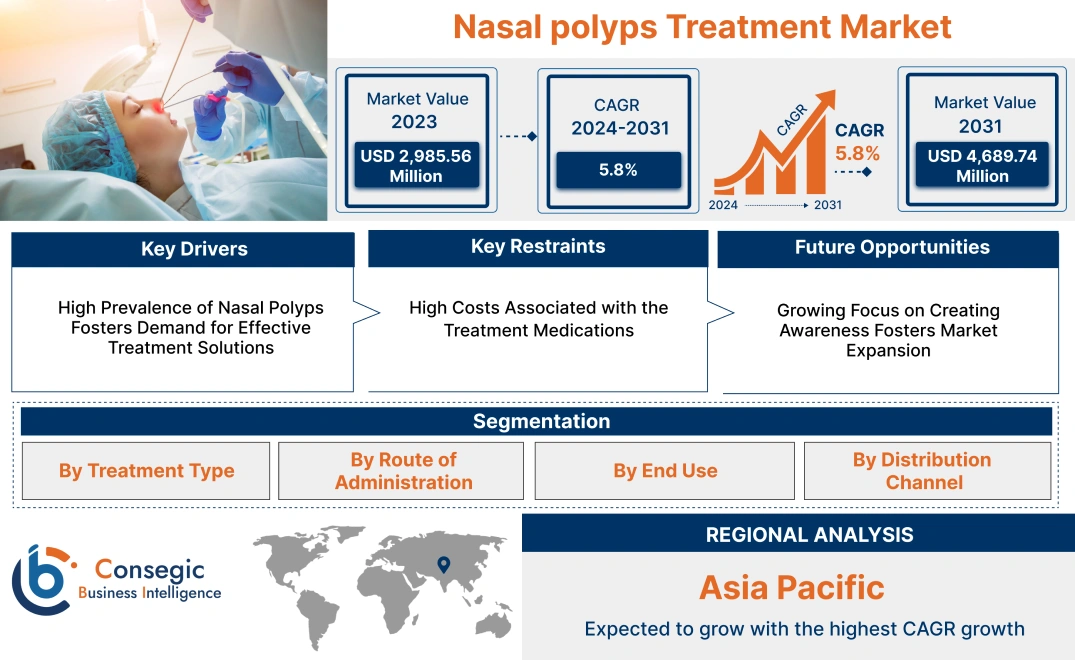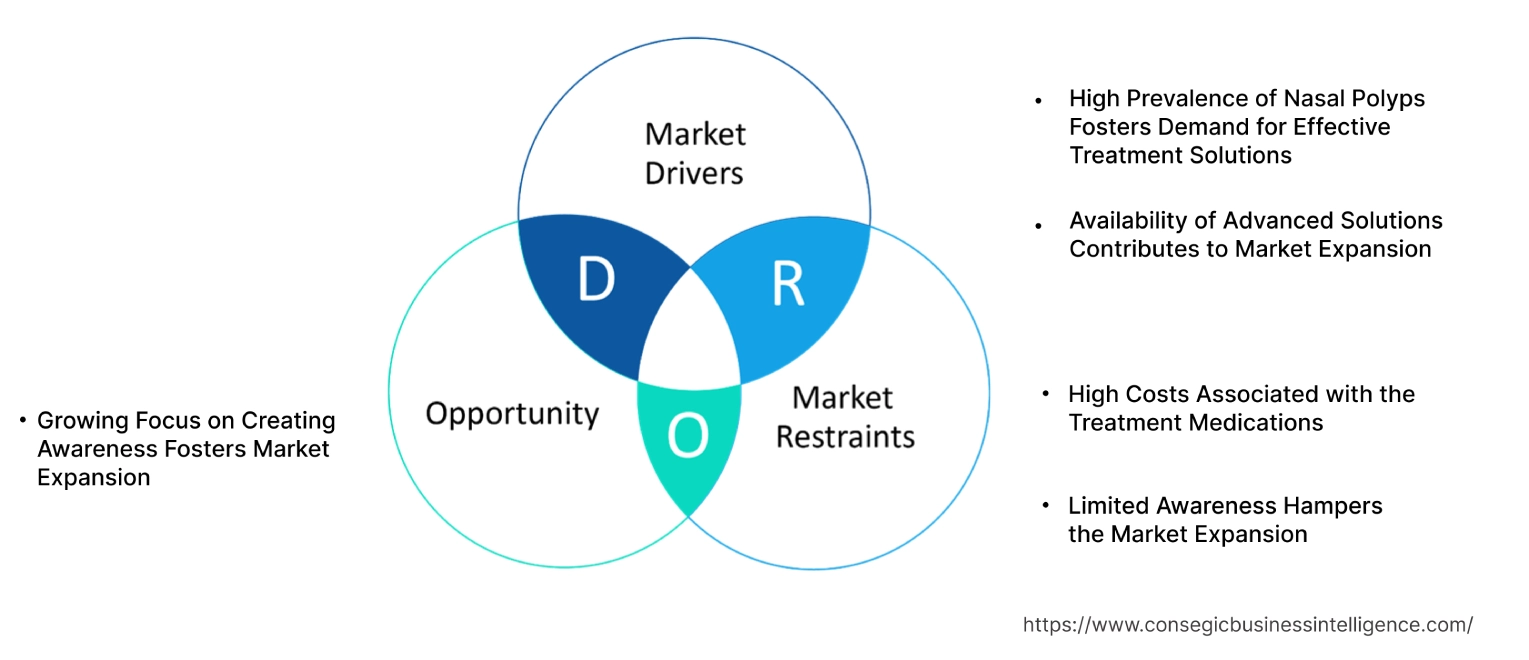- Summary
- Table Of Content
- Methodology
Nasal Polyps Treatment Market Size:
Consegic Business Intelligence analyzes that the nasal polyps treatment market size is growing with a CAGR of 5.8% during the forecast period (2024-2031). The market accounted for USD 2,985.56 Million in 2023 and USD 3,105.76 Million in 2024, and the market is projected to be valued at USD 4,689.74 Million by 2031.
Nasal Polyps Treatment Market Scope & Overview:
Nasal polyps are benign and non-malignant that develop in the lining of the nose or sinuses. These soft, painless developments are usually tear-shaped and tend to appear on both sides of the nose. Although small polyps do not pose any significant problems, larger ones can obstruct nasal passages and sinuses, resulting in breathing difficulties, congestion, and other symptoms. The appropriate treatment for nasal polyps depends on their volume and severity. Based on the analysis, the primary treatment approach for nasal polyps is medication, such as nasal corticosteroids, which includes sprays like fluticasone or budesonide. These medications reduce inflammation and shrink polyps, thereby improving symptoms like congestion and postnasal drip. In severe cases, surgical treatment may be necessary to manage nasal polyps. Endoscopic surgery is typically performed using a thin, lighted tube inserted through the nose to remove polyps and open blocked passages. As per the analysis, this minimally invasive procedure is often done as an outpatient procedure. In certain cases, balloon sinuplasty may be performed using a small balloon inserted into the sinus to open blockages.
Nasal Polyps Treatment Market Insights:
Key Drivers:
High Prevalence of Nasal Polyps Fosters Demand for Effective Treatment Solutions
Nasal polyps are painless developments inside the nose or the hollow areas inside the bones of the face, also known as sinuses. These benign inflammatory and hyperplastic outdevelopments are most commonly associated with patients with chronic rhinosinusitis and asthma. Based on the analysis, the escalating prevalence of nasal polyps is creating an increased demand for its treatment.
- For instance, according to the research article published by the Journal of Allergy and Clinical Immunology In Practice on June 06, 2022, Chronic rhinosinusitis (CRS) affects up to 12% of the general population.
- In addition to this, according to the research article published by the European Journal of Allergy and Clinical Immunology on March 31, 2022, the 5-year prevalence of adult Chronic rhinosinusitis from 2015 to 2019 in Germany accounted for 374,115 cases, with 12,989 patients classified as severe CRSwNP with inadequate disease control. On the other hand 267,880 (about 3900 per million) patients were identified as having an incident CRSwNP diagnosis between 2016 and 2019.
- According to the data published by the Centers for Disease Control and Prevention in March 2023, Asthma affects approximately 25 million people, including over 4.6 million children under the age of 18. In 2020, nearly 1 million people visited an ED for asthma-related care, and in 2020, a total of 94,560 people were hospitalized because of asthma.
As a result, the high prevalence of nasal polyps and its risk factors are fueling the nasal polyps treatment market demand.
Availability of Advanced Solutions Contributes to Market Expansion
The availability of advanced solutions such as steroid-releasing implants, functional endoscopic sinus surgery, and monoclonal antibodies for the treatment of nasal polyps. However, the ongoing advancements are leading the development and availability of innovative treatment options such as add-on maintenance treatment. Monoclonal antibody treatments for nasal polyps, particularly for chronic rhinosinusitis with nasal polyps (CRSwNP), include agents like dupilumab, mepolizumab, and omalizumab. As per the analysis, these biologics target specific pathways in the immune response, reducing inflammation and polyp volume. Dupilumab inhibits IL-4 and IL-13 signaling, while mepolizumab and reslizumab block IL-5, crucial for eosinophil activation. Clinical studies have shown these treatments significantly improve symptoms and reduce the need for surgery, offering new hope for patients with severe, uncontrolled nasal polyps. Manufacturers are developing medications with monoclonal antibodies on maintenance for the treatment of nasal polyps.
- For instance, in June 2021, GlaxoSmithKline plc, a global biopharma company, announced the US Food and Drug Administration (FDA) approval for Nucala (mepolizumab), a monoclonal antibody that targets interleukin-5 (IL-5), as a treatment for patients with chronic rhinosinusitis with nasal polyps. Nucala is the first IL-5 therapy approved as an add-on treatment in the US for adults with chronic rhinosinusitis with nasal polyps to target eosinophilic inflammation.
Overall, the rising availability of cutting-edge treatment solutions creates lucrative trends for nasal polyps treatment market growth.
Key Restraints :
High Costs Associated with the Treatment Medications
The high cost of drug development and treatment along with the adverse side effects of the nasal polyps treatment is the substantial factor that confines the development of the market. The cost of any treatment continues to upsurge. Multiple factors contribute to the high cost of drug development and treatment such as research, clinical trials, approval, and commercialization. Additionally, before any drug reaches the market, it has to undergo various research and clinical trials before public launches, this process is time-consuming and often requires a large amount of investment.
- For instance, according to data published by the Congressional Budget Office (CBO) in April 2021, estimates of the average R&D cost per new drug range from less than USD 1 billion to more than USD 2 billion per drug. Especially, for novel medications like biologics and biosimilars this cost surges as these compounds are isolated from natural sources.
Thus, the aforementioned factors are driving the expansion of the market.
Limited Awareness Hampers the Market Expansion
Limited awareness associated with biologics among physicians is hampering the market expansion. Limited awareness of biologics among physicians is significantly hindering the expansion of the nasal polyps treatment market. Many healthcare providers lack familiarity with the latest biological therapies, such as dupilumab, mepolizumab, and omalizumab, which have proven effective in managing chronic rhinosinusitis with nasal polyps. This knowledge gap leads to underutilization of these advanced treatments, resulting in persistent symptoms and complications for patients. Additionally, the absence of clear guidelines on when to initiate biologic therapy further contributes to hesitancy among physicians, ultimately stifling market expansion and patient access to innovative care options.
- For instance, according to the survey results published by the American College of Allergy, Asthma, and Immunology in November 2023, it is found that 42% of the primary care physicians surveyed were unfamiliar with asthma biologics. They didn't know the criteria for starting them, including the need for lab work, and often waited until a patient had experienced two or more exacerbations in a year before referring to an asthma specialist. Biologics have become an important tool in the treatment of asthma and other allergic diseases such as chronic rhinosinusitis with nasal polyps and eosinophilic esophagitis.
Thus, as a result despite the growing number of fundamental investigations into nasal polyps above mentioned reasons are restraining the nasal polyps treatment market growth.
Future Opportunities :
Growing Focus on Creating Awareness Fosters Market Expansion
The high prevalence of nasal polyps has motivated the initiative to create awareness. There is also an increase in campaigns by government and private organizations for awareness regarding the management of nasal polyps. There is a growing focus on creating awareness about nasal polyps due to their significant impact on quality of life. Affecting up to 40% of the population, nasal polyps can lead to symptoms such as nasal obstruction, loss of smell, and chronic sinusitis. Increased awareness aims to educate the public about symptoms, risk factors, and the importance of early diagnosis and treatment. Efforts include promoting understanding of the underlying conditions associated with nasal polyps, such as asthma and allergies, and advocating for better patient-centered care and research initiatives to address unmet needs in management and treatment options.
- For instance, the European Forum for Research and Education in Allergy and Airway Diseases announced the launch of its 2nd annual Chronic Rhinosinusitis with Nasal Polyps Awareness Day (CRSwNP) on 20 April 2023 in Brussels, Belgium. The campaign aims to raise awareness of CRSwNP and comorbidities, to encourage healthcare professionals at all levels to learn more about how they can improve outcomes for patients living with CRSwNP through improved diagnosis, treatment, and referrals to specialist care, and to educate patients on the symptoms of CRSwNP so that they can seek appropriate care in managing their disease.
Thus, consistent efforts to raise awareness are expected to create enormous nasal polyps treatment market opportunities and trends in the market.
Nasal Polyps Treatment Market Segmental Analysis :
By Treatment Type:
Based on the treatment type the market is bifurcated into medication and surgery.
Trends in the Treatment Type:
- Biologics like dupilumab and omalizumab are emerging as effective treatments for nasal polyps.
- Intranasal steroid sprays are becoming more widely used to treat small nasal polyps and prevent recurrence after surgery.
In 2023, the medication segment accounted for the highest nasal polyps treatment market share of 62.18% in the nasal polyps treatment market and it is also expected to hold the fastest CAGR over the forecast period.
- Medications serve as the primary and most preferred line of treatment for any disease.
- Corticosteroids such as fluticasone, budesonide, mometasone, triamcinolone, beclomethasone, and ciclesonide, are among the extensively utilized medications for nasal polyps treatment.
- These medications act by reducing inflammation and suppressing the immune activity which affects the nasal passage.
- They are readily available in the form of nasal spray and are relatively affordable compared to other treatment options.
- Additionally, based on the analysis, biologics have emerged as a novel solution for the treatment of nasal polyps.
- Moreover, the approval by regulatory agencies for the advanced treatment solutions is contributing to the potential expansion of the segment.
- For instance, in August 2020, Novartis AG , an innovative medicines company announced the European Commission has approval for Xolair (omalizumab) as an add-on therapy with intranasal corticosteroids for the treatment of adults with severe chronic rhinosinusitis with nasal polyps. Xolair is the only approved anti-immunoglobulin E (IgE) antibody treatment specifically designed to target and block IgE.
- As a result, the easy availability and the rising efforts to provide cutting-edge medications are forging the segment expansion and nasal polyps treatment market trends.
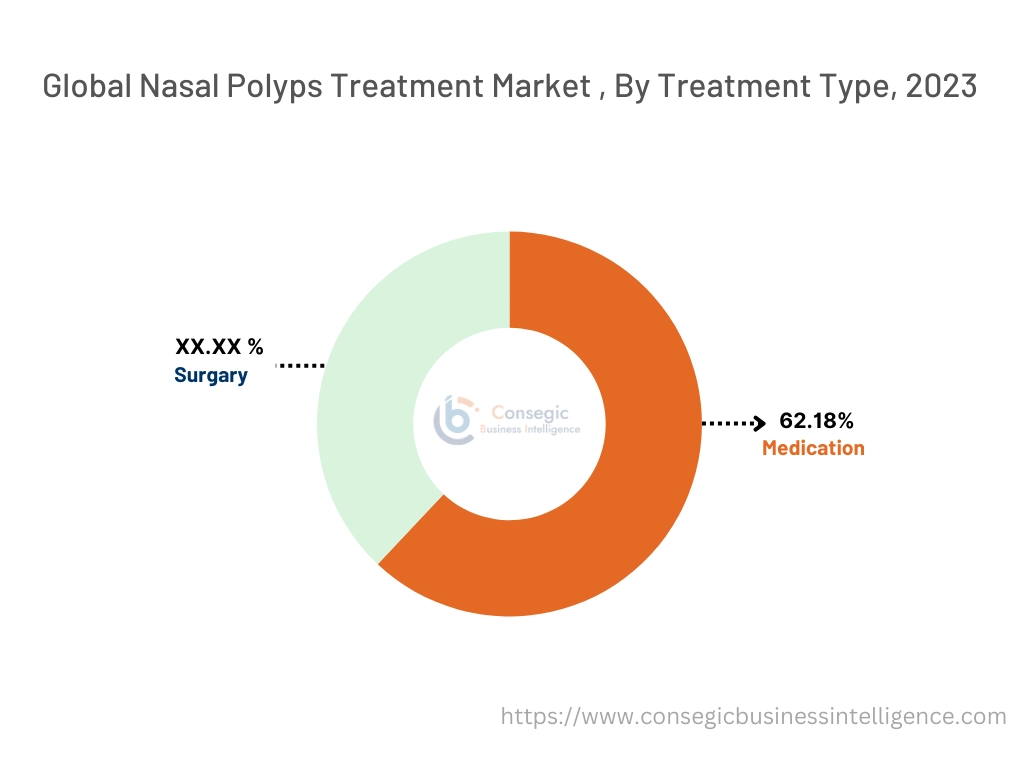
By Route of Administration:
Based on the route of administration, the market is categorized into oral, injectable, and intranasal.
Trends in the Route of Administration:
- Intrapolyp steroid injections are gaining traction as a viable alternative to surgery, particularly for patients with large or refractory polyps.
In 2023, the intranasal segment accounted for the highest market revenue share in the overall nasal polyps treatment market.
- Intranasal drug delivery occurs when particles are inhaled into the nasal cavity. Corticosteroid intranasal sprays including fluticasone, budesonide, mometasone, triamcinolone, beclomethasone, and ciclesonide among others serve the major role in the primary management of nasal polyps.
- The sprays deliver medication directly to the nasal passage increasing the bioavailability of the drug.
- Intranasal drug administration offers several benefits such as it is a less invasive method of drug delivery easily accessible for adult and pediatric patients.
- Additionally, medications administered by the intranasal route have efficacy comparable to intravenous administration and typically have superior efficacy to subcutaneous or intramuscular routes.
- Moreover, as per the analysis, the commendable efforts taken by the leading companies are contributing to the trends of the segment.
- For instance, in May 2023, Optinose, a pharmaceutical company focused on patients treated by ear, nose, and throat and allergy specialists, announced the U.S. Food and Drug Administration (FDA) accepted for review its supplemental new drug application requesting approval of XHANCE as a treatment for chronic rhinosinusitis with nasal polyps. XHANCE (fluticasone propionate) nasal spray is a drug-device combination product that combines the most widely used nasal anti-inflammatory drug with an innovative exhalation delivery system.
- As a result, the critical benefits provided by the intranasal route of administration and the novel nasal sprays by the pharmaceutical companies are boosting the segment expansion
The injectable segment is expected to hold the fastest CAGR over the forecast period.
- Several injectable medications for nasal polyps are typically administered intravenously and subcutaneously in the body.
- Intravenous administration medications increase bioavailability and also improve patient safety.
- Moreover, based on the nasal polyps treatment market analysis, increasing advances in technology for injectable drugs such as Connected drug delivery devices like smart pens are fueling the expansion of the segment.
By End-Use:
Based on the end-use, the market is categorized into hospitals, specialty clinics, ambulatory surgical centers, and others.
Trends in the end-use:
- There is a growing preference for minimally invasive procedures, such as endoscopic sinus surgery and polypectomy, which allow for quicker recovery and less postoperative discomfort.
- There is a focus on improving patient education regarding nasal polyps, treatment options, and lifestyle modifications.
In 2023, the hospital segment accounted for the highest market revenue in the overall nasal polyps treatment market, and it is also expected to hold the highest CAGR over the forecast period.
- Hospitals assist as the primary providers of vitiligo treatment.
- They play a major and crucial role in helping patients by providing convenient, affordable, and easy access to nasal polyps treatment.
- In addition to this, hospitals also offer the distribution of medications to their patients which is a key factor driving the segment expansion across the globe.
- Similarly, hospitals are equipped with state-of-the-art healthcare infrastructure, advanced treatment facilities, and medical personnel required for the better management of nasal polyps.
- Furthermore, the accelerating rise in the hospital sector is fueling the utilization of advanced medications for nasal polyps treatment and management which is further boosting the segment expansion.
- For instance, according to the data published by the National Investment Promotion and Facilitation Agency in 2023, the Indian hospital industry was valued at USD 95.50 billion in FY21 in terms of revenue and is expected to reach USD 220.68 billion by FY 2027, growing at a CAGR of 18.24%.
- Consequently, as the prevalence of nasal polyps is continuously growing, the major role played by hospitals for its treatment and the significant expansion in the hospital sector are driving the segment expansion.
By Distribution Channel:
Based on the distribution channel the market is trifurcated into hospital pharmacies, retail pharmacies, and online pharmacies.
Trends in the Distribution channel:
- The rising online pharmacies and e-commerce platforms are transforming patients' access to nasal polyp treatments.
- Pharmaceutical companies are adopting multichannel distribution strategies to reach a broader audience.
In 2023, the hospital pharmacies segment accounted for the highest market share in the overall nasal polyps treatment market.
- Hospital pharmacies play a crucial and critical role in helping patients with nasal polyps to manage their condition.
- By providing convenient, affordable, and easy access to medications such as injections and nasal sprays hospital pharmacies help patients live healthier and more fulfilling lives.
- Additionally, hospital pharmacy stores are easy to access, both for physicians, and patients alike and provide patients with information and support on how to use a nasal spray, and medications safely and effectively.
- Thus, high benefits and easy availability of medications for nasal polyps across hospital pharmacy stores are driving the segment expansion worldwide.
The online pharmacies segment is expected to hold the highest CAGR over the forecast period.
- The escalating sales of pharmaceutical products through e-commerce platforms are expected to provide lucrative prospects for online pharmacies over the forecast period.
- For instance, according to the report by India Brand Equity Foundation in July 2023, the Indian e-pharmacy market is predicted to increase at a compounded annual rate of 44% to USD 4.5 billion by 2025.
- Thus, the growing e-pharmacy sales are providing lucrative opportunities for segment expansion over the forecast period.
Regional Analysis:
The regional segment includes North America, Europe, Asia Pacific, the Middle East and Africa, and Latin America.
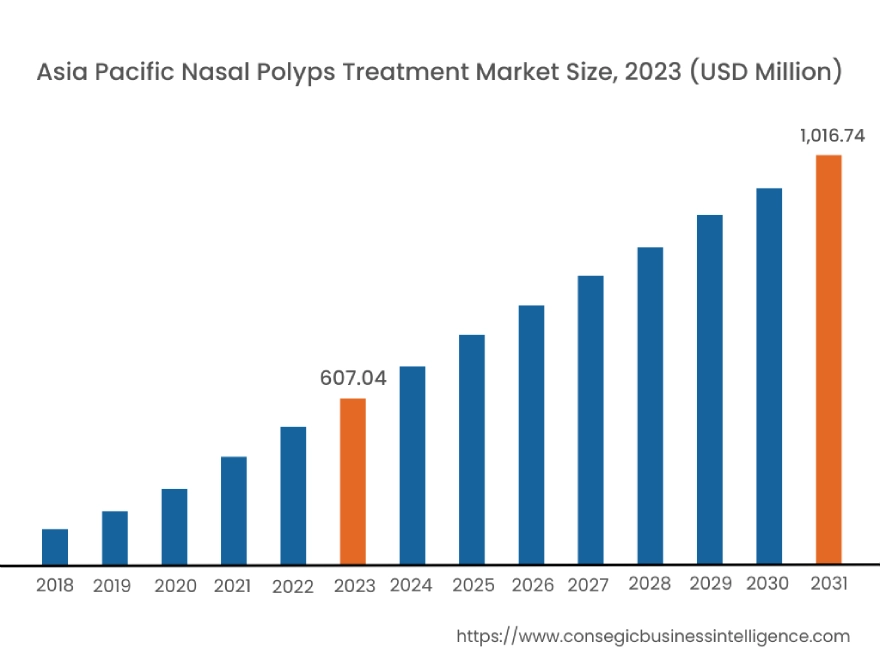
The Asia Pacific region is expected to witness significant growth over the forecast period, growing at a CAGR of 6.7% during 2024-2031. In Asia Pacific, China accounted for a major market revenue of 32.6% in 2023.
The significant growth in healthcare spending, better health awareness, and significant growth in the healthcare and pharmaceutical sectors across the region are expected to increase the treatment facilities for nasal polyps across the region.
- For instance, according to the report published by India Brand Equity Foundation, in August 2023, the market of the Indian pharmaceuticals industry is expected to reach USD 65 billion by 2024, and approximately USD 130 billion by 2030.
All these above-mentioned factors are collectively driving the demand for nasal polyps management from the pharmaceutical and healthcare industry in the Asia Pacific region and creating lucrative growth opportunities for the market.
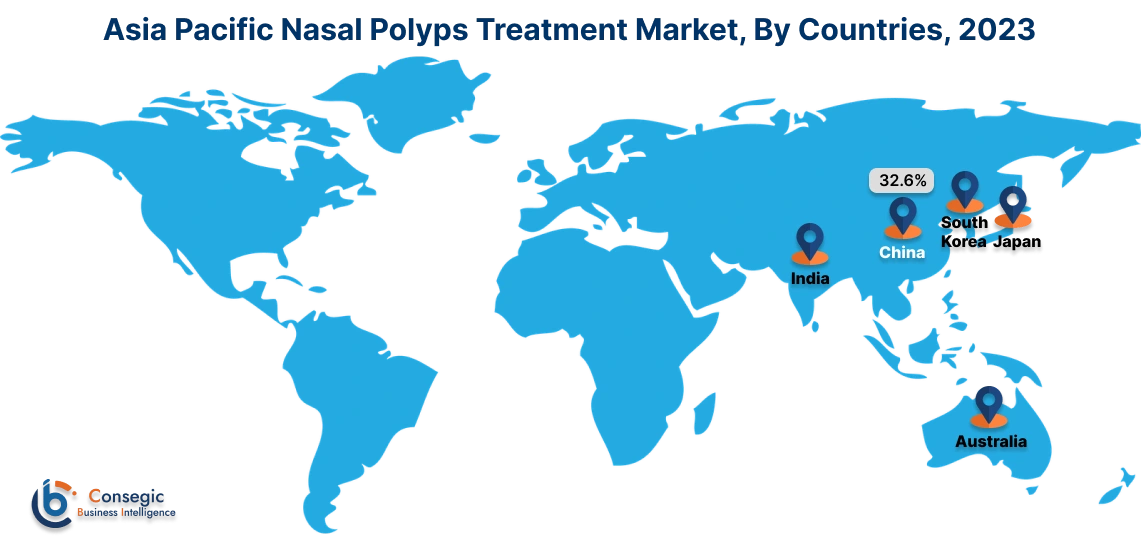
North America accounted for the highest nasal polyps treatment market share valued at USD 1,208.85 Million in 2023 and it is expected to reach USD 1,904.04 Million in 2031.
The nasal polyps treatment market across the North American region grew owing to the high prevalence of the disease, the availability of advanced medical facilities, and the presence of well-established healthcare systems across the region. Additionally, significant expansion in healthcare expenditure is aiding the market expansion in the region.
- For instance, according to the data published by the Centers for Medicare & Medicaid Services in December 2023, U.S. healthcare spending grew 4.1% to reach USD 4.5 trillion in 2022, faster than the increase of 3.2% in 2021. Moreover, North America is home to several pharmaceutical companies actively involved in researching and developing new and improved treatments for nasal polyps.
Thus, the growing demand for pharmaceutical research and development spending and government healthcare spending across the region are driving market growth.
Europe is anticipated to witness substantial growth that is backed by the increasing adoption of advanced treatment options for maintaining the condition properly. Companies invest in innovative technologies to cater to the surging demand for this treatment across the region.
The Middle East, Africa, and Latin America are expected to grow at a considerable rate due to increasing investments in research and development and growing medical sectors in countries like Brazil, and UAE, among others.
Top Key Players & Market Share Insights:
The global nasal polyps treatment market is highly competitive, with several large players, and numerous small and medium-sized enterprises. These companies have strong research and development capabilities and a strong presence in the market through their extensive product portfolios and distribution networks. The nasal polyps treatment industry is characterized by intense competition, with companies focusing on expanding their product offerings and increasing their market share through mergers, acquisitions, and partnerships. The key players in the market include-
- Sanofi (France)
- Regeneron Pharmaceuticals, Inc. (U.S)
- Genentech USA, Inc. (Subsidiary of Roche)(U.S)
- Novartis Pharmaceuticals Corporation. (Switzerland)
- AstraZeneca(UK)
- GSK plc. (UK)
- OptiNose US, Inc. (U.S)
- INTERSECT ENT, Inc. (Subsidiary of Medtronic)(U.S)
- Sun Pharmaceutical Industries Ltd.(India)
- AdvaCare(UK)
Recent Industry Developments :
Merger & Acquisition:
- In January 2024, GSK plc. announced the acquisition of Aiolos Bio, Inc. a clinical-stage biopharmaceutical company focused on addressing certain respiratory and inflammatory conditions, for a USD 1 billion upfront payment and up to USD 400 million in certain success-based regulatory milestone payments. The acquisition provides GSK with access to Aiolos' AIO-001, a potentially best-in-class, long-acting anti-thymic stromal lymphopoietin (TSLP) monoclonal antibody ready to enter phase II clinical development for the treatment of adult patients with asthma, with potential for additional indications including chronic rhinosinusitis with nasal polyps.
- In May 2022, Medtronic plc., a global leader in healthcare technology, announced the acquisition of Intersect ENT, expanding the company's comprehensive ear, nose, and throat (ENT) portfolio with innovative products used in sinus procedures to improve post-operative outcomes and treat nasal polyps.
Nasal Polyps Treatment Market Report Insights :
| Report Attributes | Report Details |
| Study Timeline | 2018-2031 |
| Market Size in 2031 | USD 4,689.74 Million |
| CAGR (2024-2031) | 5.8% |
| By Treatment Type |
|
| By Route of Administration |
|
| By End Use |
|
| By Distribution Channel |
|
| By Region |
|
| Key Players |
|
| North America | U.S. Canada Mexico |
| Europe | U.K. Germany France Spain Italy Russia Benelux Rest of Europe |
| APAC | China South Korea Japan India Australia ASEAN Rest of Asia-Pacific |
| Middle East and Africa | GCC Turkey South Africa Rest of MEA |
| LATAM | Brazil Argentina Chile Rest of LATAM |
| Report Coverage |
|
